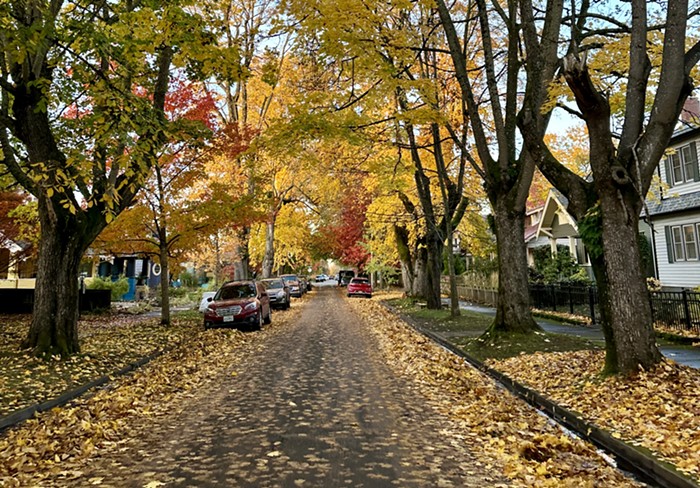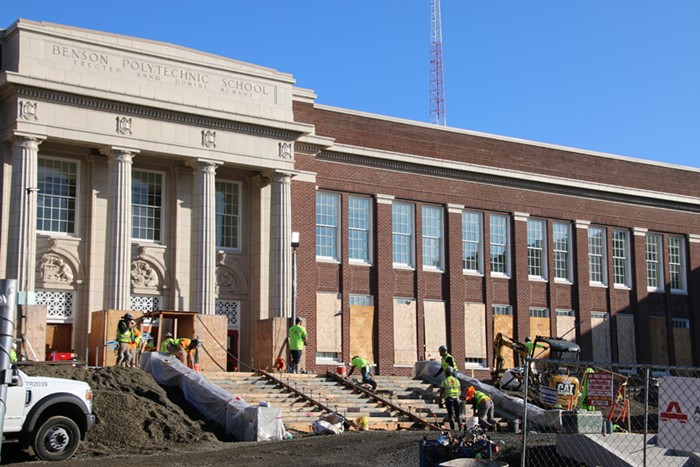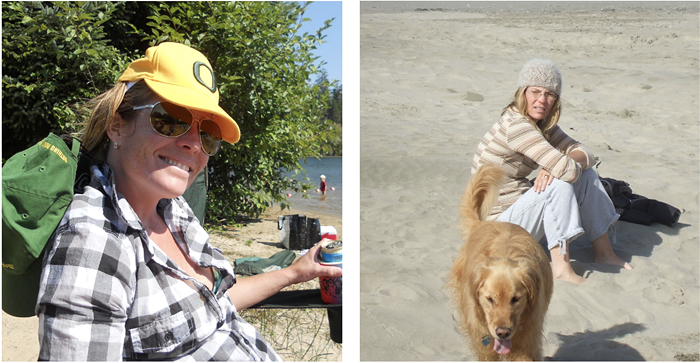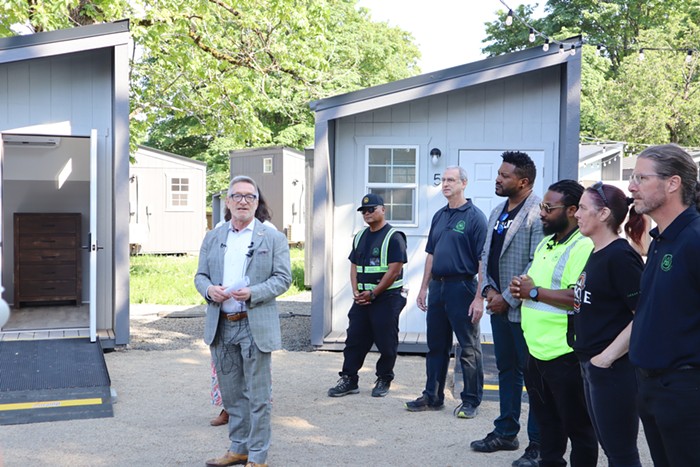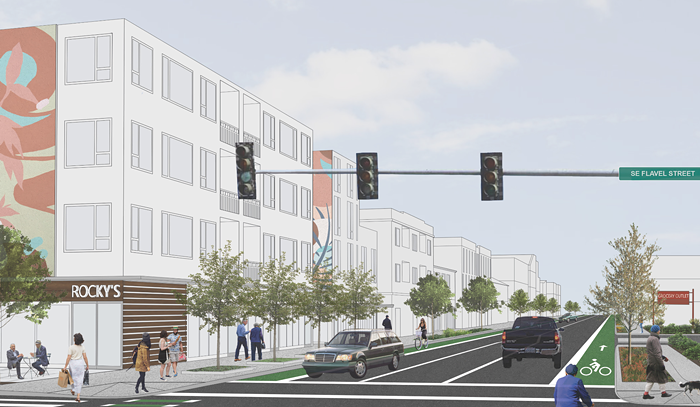QUINN COLLING knows he saw the tent just a couple of days ago.
Colling's always on the lookout for new makeshift shelters around town. It's been his job for the better part of a decade. And he's sure this lot—across Interstate 5 from the twinkly condo towers of South Waterfront, beneath the ever-expanding splendor of Oregon Health and Science University up on the hill—contained a homeless camp.
But tonight, January 28, a headlamp beam shows the small wooded patch is empty. Just like the undersides of many of the overpasses Colling has been scouting for the past hour, and the pebbly stretch of riverbank he'll check next.
"The hit rate is not going to be as good out here," says Colling, a bearded, hoodie-clad outreach worker with the social services agency JOIN. "They're living on the outskirts because they don't want to be found."
The problem is, this is the night when finding counts most.
Every two years, social services agencies and government workers undertake the massive, partly futile effort of trying to tally how many people are homeless in Multnomah County. In shelters and on the streets, volunteers and social workers fan out, administer surveys, and perform headcounts, looking anywhere they can think to check.
On the night the Mercury meets up with Colling and two of his colleagues, the count's just beginning. The effort will continue for the next week, but the question will remain the same: Were you sleeping outside, or in a homeless shelter, on January 28?
This "point-in-time study" is more than idle curiosity. The count is a prerequisite for millions in federal funding available to programs assisting the homeless. The US Department of Housing and Urban Development alone kicked more than $14 million to local efforts in 2014.
City and county officials also look to the tally for guidance on where to focus those resources. And the count is one of the best, most-cited yardsticks for how Portland's faring in the fight against homelessness.
Lately, the news hasn't been great. The last count, in 2013, found 2,869 people sleeping outside or in an emergency shelter—nearly 150 more than in 2011. More people were classified as long-term or "chronically" homeless than in 2011, with half of respondents saying they'd become homeless within the year.
The 2013 count also turned up 171 more homeless women. Minorities, overall, were overrepresented by 16 percentage points compared to the county's general population.
But those numbers are still only a piece of the real picture.
"Due to the inherent difficulty of obtaining a complete count of everyone who is homeless on a given night, the actual number of people who were homeless in Multnomah County... is likely higher than the number documented in this report," the 2013 study said.
The big question, now, is how 2015's incomplete picture might stack up.
The night is warm—around 50 degrees. Colling rides shotgun in fellow outreach worker Lio Alaalatoa's blue pickup truck, the satellite radio pumping an erratic selection of Bob Marley, Dixie Chicks, and Backstreet Boys. Cristina Castaño, another JOIN staffer, sits in the four-door cab's backseat, mostly mocking the music.
The group's task is tricky. While other teams scour the alcoves and bridge bottoms of downtown or popular clearings along the Springwater Corridor Trail, these three have been assigned a chunk of Southwest Portland that attracts relatively few homeless campers.
"This far out, there are fewer people," Colling says. "But we're also very comfortable going out to these camps—the ones where you kind of have to crawl."
Alaalatoa eases the truck onto a curb near SW Naito and Barbur, stopping on a grassy patch across from a low overpass. The team quickly crosses the road, and, after a brief search, finds a man tucked back among the bridge's supports. It would be impossible to spot him from the road.
The man is sleeping, so Alaalatoa wakes him up, and asks if he'll take the survey.
"I'm cool," he says. "I just want to be left alone."
Responses like this are an impediment to an accurate tally. In order to list someone in the official results, outreach workers must have a person's first initial, the first three letters of their last name, their age, and their gender—a safeguard against double-counting. Anyone who doesn't want to participate can be counted, but they'll show up only in an appendix to the main report. The 2013 count documented nearly 370 people who didn't give their information.
This time, though, the JOIN staffers are lucky.
"Is that George?" Colling asks, back at the truck.
"Oh yeah, that's George," Alaalatoa replies. They've been working with the guy for years and already know enough to fill out a survey form.
The JOIN staffers slowly make their way south. Not all of the bridges they're seeking are as accessible as George's. Some span small gullies, with slopes smothered in painful blackberry thorns and slippery rocks. Some spots require crouching and ducking through fences.
Colling jokes that he doesn't own a good pair of pants because of the job.
There are human-caused pitfalls, as well. At one stop, Colling decides to check an underground hallway meant to shepherd the public beneath Naito's ceaseless traffic. Alaalatoa warns him not to bother, saying the tunnel is little more than a public toilet, but Colling descends anyway.
He's back quickly, gagging. No one down there.
It's hard to say for sure, but the lack of people Colling, Alaalatoa, and Castaño come across tonight could be partly influenced by city policy. As the Mercury first reported, Housing Commissioner Dan Saltzman on January 20 sent an "urgent reminder" to more than a dozen local law enforcement, government, and private organizations asking them to curb enforcement against the homeless from January 21 to February 3.
"To ensure that the count is as accurate as possible, we are requesting that all entities in Multnomah County that enforce the anti-camping ordinance or conduct homeless camp cleanups suspend enforcement," Saltzman wrote.
With camp cleanups already on hold for a week on January 28, it's possible people who might otherwise be escaping scrutiny out in far-flung Southwest have moved to more-central locations.
In all, the group from JOIN contacts fewer than 10 people on this night, with just three officially counted. The men they come across—they're all men—are universally polite, even if they don't want to participate. Some perk up at the name "JOIN." They're hoping to get help for addictions or mental health issues. Colling hands out his card.
A guy named Russell, sheltered beneath a tarp beside SW Naito, says he's been trying to find a place to live for months, but that he's had a hard time because he doesn't have an addiction or mental health issues. Colling hands out his card, but acknowledges the difficulty. Access to Portland's famously limited supply of affordable housing, the JOIN workers say, is their biggest ongoing struggle.
The last person the outreach workers encounter is seated, with several tall cans of Olympia, on the front steps of First Christian Church, across from the South Park Blocks. Colling approaches without his survey clipboard, and starts chatting him up.
The man's name is Dane, he says, and he's been on Portland's streets for years. He's never heard of JOIN but says he might check it out. The organization's headquarters on NE 81st offer showers, lockers, and other daytime amenities, and see hundreds of visitors a week.
The only problem for Dane: NE 81st is a long way from the First Christian Church.
"This is my turf!" he tells Colling. "The police know me. Everybody knows me."
They shake hands, and Colling returns to the truck to fill out a survey sheet. The conversation has revealed a lot about Dane—enough, anyway, that he can be added to this year's official count.

